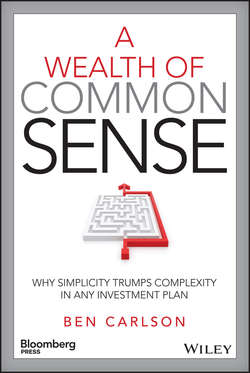A Wealth of Common Sense

Реклама. ООО «ЛитРес», ИНН: 7719571260.
Оглавление
Carlson Ben. A Wealth of Common Sense
Introduction: Why Simplicity Is the New Sophistication
Noise
How Hard Can It Be?
CHAPTER 1. The Individual Investor versus the Institutional Investor
Institutional versus Individual Investors
We're All Human
Extra Zeroes
Long-Term Thinking
Key Takeaways from Chapter 1
CHAPTER 2. Negative Knowledge and the Traits Required to Be a Successful Investor
The Biggest Problem of All
Traits of a Successful Investor
Standing on the Shoulders of Giants
Key Takeaways from Chapter 2
CHAPTER 3. Defining Market and Portfolio Risk
Volatility: Risk or Opportunity?
Understanding Rule Number 1 of Investing
The Risk Tolerance Questionnaire
Risk versus Uncertainty
Risk Aversion
The Cycle of Fear and Greed
Key Takeaways from Chapter 3
CHAPTER 4. Market Myths and Market History
Myth 1: You Have to Time the Market to Earn Respectable Returns
Myth 2: You Have to Wait until Things Get Better Before You Invest
Myth 3: If Only You Can Time the Next Recession, You Can Time the Stock Market
Myth 4: There's a Precise Pattern in Historical Market Cycles
Myth 5: Stocks and Bonds Always Move in Different Directions
Myth 6: You Need to Use Fancy Black Swan Hedges in a Time of Crisis
Myth 7: Stocks Are Riskier Than Bonds
Myth 7a: Bonds Are Riskier Than Stocks
Myth 8: The 2000s Were a Lost Decade for the Stock Market
Myth 9: New All-Time Highs in the Stock Market Mean It's Going to Crash
Myth 10: A Yield on an Investment Makes It Safer
Myth 11: Commodities Are a Good Long-Term Investment
Myth 12: Housing Is a Good Long-Term Investment
Myth 13: Investing in the Stock Market Is Like Gambling at a Casino
Key Takeaways from Chapter 4
CHAPTER 5. Defining Your Investment Philosophy
Degrees of Active and Passive Management
The Benefits of Doing Nothing
Exercising Your Willpower
Simplicity Leads to Purity
Defining Yourself as an Investor
Key Takeaways from Chapter 5
CHAPTER 6. Behavior on Wall Street
Threading the Needle
So Never Invest in Active Funds?
The Most Important Thing
Key Takeaways from Chapter 6
CHAPTER 7. Asset Allocation
Asset Allocation Decisions
Why Diversification Matters
Mean Reversion and Rebalancing
Risk Factors, Value Investing, and the Power of Patience
The Value Premium
The Rise of Smart Beta
How to See It Through
Key Takeaways from Chapter 7
CHAPTER 8. A Comprehensive Investment Plan
Why Do You Need a Plan?
The Investment Policy Statement (IPS)
Lifecycle Investing
Beating the Market
Saving Money
Taxes and Asset Location
Key Takeaways from Chapter 8
CHAPTER 9. Financial Professionals
Vetting Your Sources of Financial Advice
Outsourcing to a Financial Professional
What a Financial Advisor Can Do for You
How to Be a Good Client
Benchmarking and Ongoing Maintenance
Alternatives
Key Takeaways from Chapter 9
Conclusion
Book List
About the Author
Index
WILEY END USER LICENSE AGREEMENT
Отрывок из книги
In 1776, Thomas Paine, a political activist, philosopher, and poet published a simple pamphlet that likely altered history as we know it. The title of his publication was plain and simple —Common Sense. This tiny pamphlet, which numbered less than 90 pages, inspired the original 13 colonies to seek their independence from Great Britain and form the United States of America. It's been said that virtually every rebel read, or at least listened to, the words written by Paine. This was Paine's introduction to Common Sense:
Paine's simple words ignited the people of that day to fight for their independence. As John Quincy Adams, the second president of the United States, once said, “Without the pen of the author of Common Sense, the sword of Washington would have been raised in vain.” Paine's plain, common sense arguments provided the motivation that was so desperately needed to unite people from all walks of life to stand together in their cause. So why did Paine's words resonate with so many people? In a word – simplicity. Many writers of that day and age used dense philosophy and Latin to get their point across. Paine made his case for the benefits of independence by using clear, concise language that everyone could understand. Common Sense worked well with the crowds in the taverns, but was sophisticated enough to be given credibility by the Colonial dignitaries.2 His words lived up to the title, as common sense works on a number of levels.
.....
For example, there are now over 77,000 mutual funds to choose from worldwide.7 As the number of investment options available to investors continues to increase there is the assumption that complex approaches must be better. In fact, I will show that less is always more and trying to implement a more interesting or clever portfolio strategy is akin to threading the needle. Sure, it can work, but trying harder and increasing the number of decisions you make only increases the odds that you'll make a mistake.
The financial markets are a messy, complex system that is constantly evolving. But the answer to a complex system isn't necessarily a complex investment portfolio that requires constant activity. On the contrary, the best response to the complexities inherent in the markets is a portfolio management process that relies heavily on simplicity, transparency, and reduced levels of activity. One of the ultimate status symbols in the financial world is to consider yourself a sophisticated investor. This word invokes feelings of superiority and privilege. Sophistication is defined as having a great deal of experience, wisdom, and the ability to interpret complex issues. But sophistication does not mean that you have to utilize complexity, just that you understand it. Nassim Taleb explains this dynamic in his book Antifragile:
.....